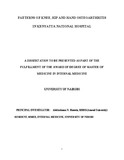| dc.contributor.author | Hussein, Abdirahman N. | |
| dc.date.accessioned | 2013-11-12T11:45:45Z | |
| dc.date.available | 2013-11-12T11:45:45Z | |
| dc.date.issued | 2013 | |
| dc.identifier.citation | Master Of Medicine In Internal Medicine | en |
| dc.identifier.uri | http://erepository.uonbi.ac.ke:8080/xmlui/handle/11295/58691 | |
| dc.description.abstract | Background
Osteoarthritis (OA) is a common and devastating joint disease. Its prevalence is increasing with an increase in life expectancy and the rising of epidemic obesity. A signif icant number of patients have a major degree of limitations in their daily activities. The risk of developing the disease increases with aging. Obesity (high body mass index) is not only a major risk factor for the development of OA of the knee, hip and hand but the progression of established disease. Maintaining an ideal weight reduces the incidence and the severity of the disease which will improve the quality of the life of patients living with the disease. On the other hand, joint replacement for severe OA is not feasible in the majority of the developing countries, hence emphasizing the need for the prevention of the disease through modifying the modifiable risk factors.
Objective of the study
We set out to determine the patterns of knee, hip and hand OA in patients attending Kenyatta
National Hospital rheumatology and orthopedic outpatient clinics.
Methodology
This was a cross-sectional descriptive hospital based study which was carried out from 24 th August to 21st of December 2012.Adults aged 18 years and above with a diagnostic label of knee, hip and hand OA were interviewed. Every participant was examined and their heights and weights were taken and BMI was calculated. Blood samples were taken for erythrocyte sedimentation rate (ESR). Data analysis was then done using statistical package for social scientists (SPSS) version 17.
Results
Two-hundred and one patients with knee, hip and hand OA were consecutively evaluated. There were 165 females and 36 males, with the mean age of 61.4 ±11.1. The mean BMI of the patients was 29.0 ±5 Kg/M2 with a median duration of the disease before presentation for five years. Of the 201 patients studied, 77% had knee OA, 15% hip OA, 3% hand OA, and 5% combined knee and hip OA. Obese participants comprised 41.2% and overweight were 32.3%. There were
89(42.3%) patients with bilateral disease compared to 112(55.7%) with unilateral disease. Obese participants had higher prevalence of bilateral disease (52.4%) compared to participants with normal BMIs (26.5%).
Conclusion
Patterns seen in our study sample was similar to what has been reported in other studies in Africa and Europe. Obesity is prevalent in patients with knee and hip OA. | en |
| dc.language.iso | en | en |
| dc.publisher | University of Nairobi | en |
| dc.title | Patterns Of Knee, Hip And Hand Osteoarthritis In Kenyatta National Hospital | en |
| dc.type | Thesis | en |
| dc.description.department | a
Department of Psychiatry, University of Nairobi, ; bDepartment of Mental Health, School of Medicine,
Moi University, Eldoret, Kenya | |
| local.publisher | School of Medicine | en |

